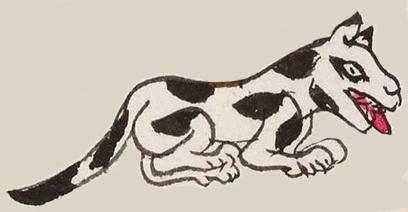chichi (Mdz32r)
This glyphic element has been carved from the compound sign for the place name, Chichiccuauhtla. This representation of a dog (chichi) shows an animal in profile, facing to the right, crouching or lying on the ground, and with a red tongue protruding. The dog is white with large black spots and a long tail. Its ears are erect and pointing forward, and some of its teeth are visible.
Stephanie Wood
From the gloss, we can see that chichic (bitter) is the intention over chichi (dog) in the original compound, with the resulting place name having something more to do with a bitter tree. But the dog is included here as a logographic noun.
This black and white spotted dog looks nearly identical to the representation of the izcuintli that also appears in the Codex Mendoza (see below, right), except that the izcuintli is shown with black ears. Whether that distinction is intentional is unclear. Neither one is the Mexican hairless. There were various pre-Hispanic dogs in Mexico. The Florentine Codex describes some of them. The term chichi is also found spelled tlalchichi, presuming that both terms refer to the same dog. Other names for indigenous dogs were: xolotl, itzcuintli, xoloitzcuintli, chichitzcuintli, and tehui. The Anthropology department at the UNAM suggests that dogs have been in Mexico for about 7,000 years. The itzcuintli was a day sign in the tonalpohualli day count. Dogs could also be assumed by nahualli spirits, as described in our online dictionary.
Stephanie Wood
c. 1541, but by 1553 at the latest
Stephanie Wood
Joseph Scott and Crystal Boulton-Scott
animals, animales, dogs, dog, tongue, perros, lenguas, xiuhpohualli, año, turquesa, xihuitl

chichi, dog, https://nahuatl.wired-humanities.org/content/chichi
dog
el perro o la perra
Codex Mendoza, folio 32 recto, https://digital.bodleian.ox.ac.uk/objects/2fea788e-2aa2-4f08-b6d9-648c00..., image 74 of 188.
The Bodleian Libraries, University of Oxford, hold the original manuscript, the MS. Arch. Selden. A. 1. This image is published here under the UK Creative Commons, “Attribution-NonCommercial-ShareAlike 3.0 License” (CC-BY-NC-SA 3.0).




